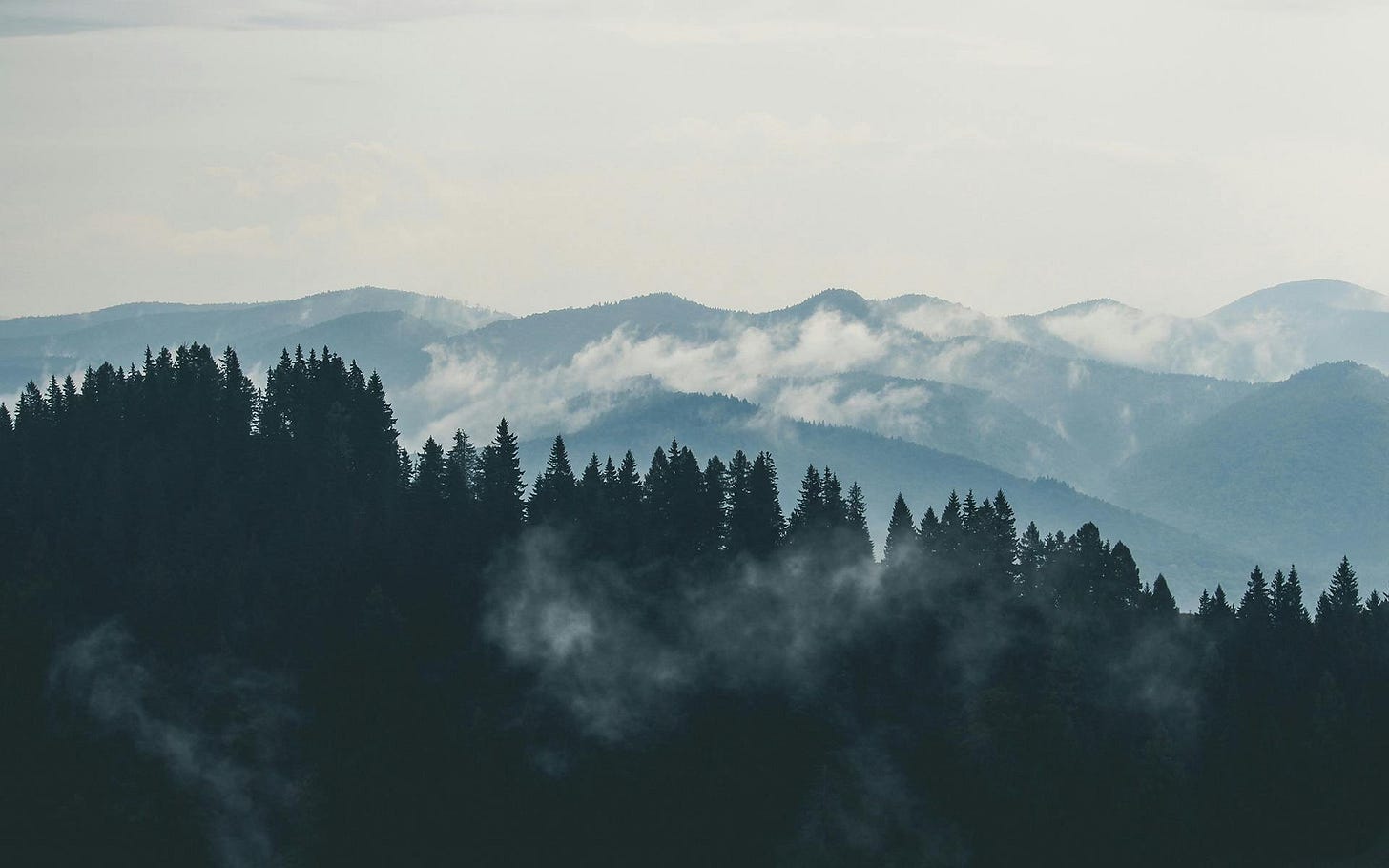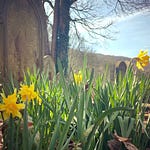‘You can possess a forest and be possessed by it.’ Ursula K Le Guin
A note on the prompts & monthly depth writing pod
At the end of this dispatch you’ll find depth writing prompts to channel your creativity & expand your sense of possibility. You can interpret the prompts any way you wish. You might want to do them now or when you have a quiet moment later on. You can do them on your own or with a friend. Or you can join the monthly depth writing pod on Monday November 11th 7pm - 8.15pm GMT to do the prompts with others in a friendly & supportive online space.
Free to paid subscribers - RSVP or use the zoom link in the footer to join the workshop
Not a paid subscriber but would like to join in? No problem book your place here
Read on or listen to the audio to explore:
Forests as symbols of complexity and enchantment.
Why cutting down trees is a suicidal act.
How forests can sensitise us to the invisible web at the heart of life.
Image: Pexels
Shadows and roots
Drawing on both science and ancient wisdom, Carl Jung viewed humanity as part of an invisible matrix that holds all things together in which we are not separate from nature, we are nature. In fairy tale and myth, the forest in particular is a place of magic and enchantment. Here in this dense, dark web of trees, the familiar gives way to the strange and the daylight realm of the solid dissolves into the mists of the ephemeral and numinous.
We wander the forest’s dark paths, temporarily plunged into a rhizomatic world of shadows and roots teeming with all that is invisible and hidden. The rustle of feathers, the swish of tails and the mycelial sprawl of what grows below ground invite us into an imaginal realm beyond the grasp of consciousness alone. In meeting with the wildness of the forest, we are called back to the instinctual nature of our own wildness. We may be eaten alive or learn to survive.
Alchemical domains of transformation and magic, forests are the lungs of the world. Living alembic systems, they breathe in carbon dioxide and light and breathe out oxygen, while also producing sugars. They purify the air and emit natural anti-depressants in the form of arboreal pheromones. As botanist and medical biochemist Diana Beresford-Kroeger writes in her memoir To Speak For The Trees; ‘Trees don’t only maintain the conditions for human and most animal life on earth, they created these conditions through the community of forests.’
Scientifically speaking, we share the same breath. Spiritually speaking, we share the same soul.
A suicidal act
Over the years, I’ve treasured my visits to friends who live on the edges of the sprawling Sitka spruce forests of Scotland’s Galloway and Dumfries region. I’ve fond recollections of striding down crystalline avenues of trees bristling with hoar frost, my lungs cracking with ice and of crawling among ‘fairy circles’ of fly agarics in the forest understory while foraging for chanterelles, inky blue caps and ceps. I particularly remember the astonishment of waking one morning following a night of heavy rain to find a silvery net of spider webs wrapping the trees, rendering the luminous warp and weft of the forest momentarily visible.
On a recent visit I set off along the forest path as usual. A light wind ruffled the green tulles of the branches, transforming the trees into slender ballerinas dancing in place to the music of the robins and siskins coming from somewhere inside them.
But then I turned a corner and the dancing suddenly ended, stopping me dead in my tracks. There were no trees, no birds, no lichen, no ferns, no heather, no mushrooms, no moths, no moss. Only a giant expanse of soggy black peat extending as far as I could see and the sickly-sweet smell of sap weeping from the logs that had been roughly piled into pyramids at its edges. And silence. Stifling, deathly and thick where the fertile darkness of the forest had been mechanically erased.
Since I knew this forest to be a commercial mono-crop designated for logging on reaching full growth, I shouldn’t have been shocked. But seeing the desolate black stumps where the dancing rows of Sitka had so very recently grown felt like a punch to the gut.
I knew, too, that this barren patch of earth wouldn’t be planted for another nine years, meaning that, bereft of its mossy cover, the exposed peat would die too - fatally releasing tonnes of carbon into the atmosphere, rather than storing it and supporting new growth.
What chilled me further was the thought of my own complicity in the extractive violence of the logging. As a writer, could I say for sure I had never bought a book or journal – or loo roll or firewood or furniture for that matter - that had not come from a sustainable source? I could be angry and blame the loggers, big-agro, necro-capitalism. Or I could understand myself as belonging to a different kind of complex web in which forests are resources to be extracted, felled and possessed.
What I had witnessed, of course, is just one small part of a global predicament with dire consequences for all life on earth. According to a recent report by the International Union for the Conservation of Nature (IUCN), 38% of the world’s trees are at risk of extinction with logging being a primary cause of degradation, along with livestock grazing and road construction. While a 2021 Global Tree Assessment (GTA) report shows that 142 tree species are already recorded as Extinct or Extinct in the Wild.
Speaking not only as a scientist but also as an activist who was brought up in the Celtic druid tradition, Diana calls the cutting down of trees ‘a suicidal act’. Meanwhile it’s this lost connection to nature and the unitive web at the heart of existence which Jung viewed as the greatest crisis facing humanity.
The strange absence of sound ringing in my ears, I sunk down on the damp sump of what was left of a trunk. Witnessing the violence of the logging was different to knowing about it from afar. This patch of earth I had learned to love was gone and I felt sick with sadness.
The word for world is forest
A month later I found myself in another forest, this time in the rural Alentejo region of Portugal where I was leading a depth writing retreat. A world away from the densely planted Sitka forest, this was a light, airy forest constellated with cork trees.
Like the Sitka, the cork forests, too, are an agro-crop. But where the logging of the forest in Galloway and Dumfries had eviscerated the landscape, the tiradores or cork strippers of Alentejo work in harmony with the cork, neither cutting too deep nor too hard to ensure the sleeves of bark will rejuvenate and grow back.
From a distance, the crowns of the cork looked like low-hanging clouds hugging the red earth. Close up, the low leafy arches formed by the pillars of rain-blackened trunks forking into thick branches with long, tapering, fingers that seemed to be clasping their neighbours brought to mind the hushed cloisters of a medieval monastery. While the felled forest in Scotland had felt like a graveyard, this forest felt sacred and alive with the mystery of the ages.
A keen explorer of the shape-shifting porosity between realms, alongside the modern tendency to disregard it, the science fiction writer Ursula K Le Guin set her award-winning 1972 novella on a planet comprised entirely of trees. In the book, written as an allegory about the Vietnamese war, the planet Athshe has been colonised by brutal yumens bent on logging it into oblivion. But the Athsheans themselves are a gentle breed of hominoids whose lithe hairy limbs are almost indistinguishable from the vines and creepers that grow up the trees. To the Athsheans the ‘dream-time’ of the forest is just as real as the ‘world-time’. The Athshean word for world, meanwhile, is simply ‘forest’.
So it was that in the dream-time of the cork forest, a small group of folk from different generations, backgrounds and beliefs wrote together, united by that deeper root which connects all things. In this shifting, porous place of transformation and enchantment, invisible doors were unlocked and the imagination of the world was unveiled in the iridescence of the dew, the gymnastics of the grasshoppers and the cork trees growing back their skin cell by cell.
Possessed by the forest, we put our trust in the dark - only to discover even more doors.
If you enjoyed this dispatch please do ‘heart’ & share so that others can find it – thanks so much!
Let’s discuss in the comments below
What are the ways in which societies treat forests as possessions? Where have you noticed this in particular? What do you see as being the consequences of this?
What campaigns, initiatives and platforms are advocating for the protection of our forests and trees? What difference are they able to make?
What can we learn from the wisdom of forests?
Depth writing prompts
Write about an experience of being in a forest or wood or simply amongst trees in as much sensory detail as you can. Or go out into a forest, wood, park etc and write in place. What did/do you feel? What did/do you notice?
Reflect – to what extent do you feel a part of a web of capitalism, colonialisation and extraction? And to what extent do you feel part of a web of life? In both cases, where and when do you notice this the most? How does it make you feel?
Imagine you are a forest – what do you see, hear, feel? What do you know? What do you dream?
Join the monthly Depth-Writing Pod on Monday November 11th, 7pm-8.15pm GMT
Press pause on the busyness of life, connect with others and, most importantly, have time just for yourself to write in response to this month’s prompts. You are don’t need any writing experience to join and there will be no pressure to read anything out. All you need is a spirit of adventure and curiosity!
Paid subscribers - RSVP to this email or join with the zoom link in the footer below.
N.B. Although depth-writing is therapeutic, it’s not therapy, so let the words lead but only as far as want to go.
By joining this workshop, you are agreeing to practice CARE - confidentiality, attention, respect & empathy - with others.













Share this post